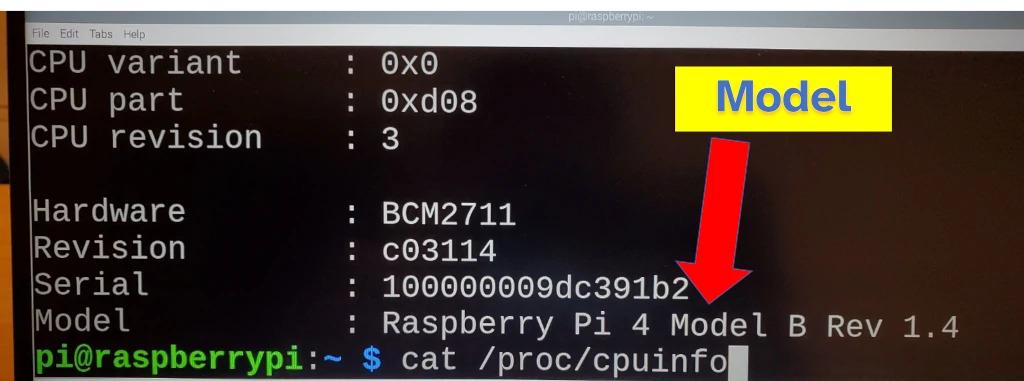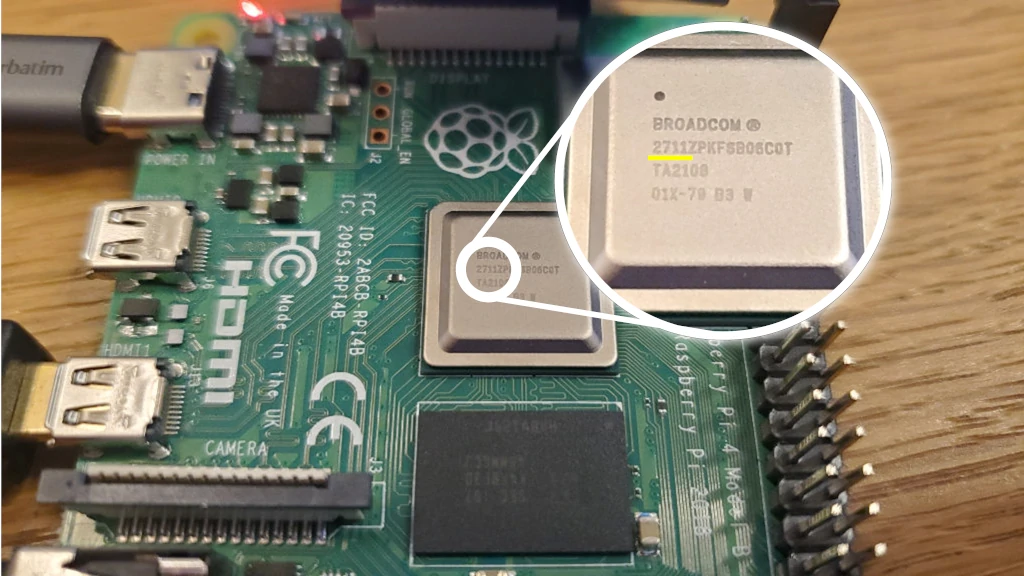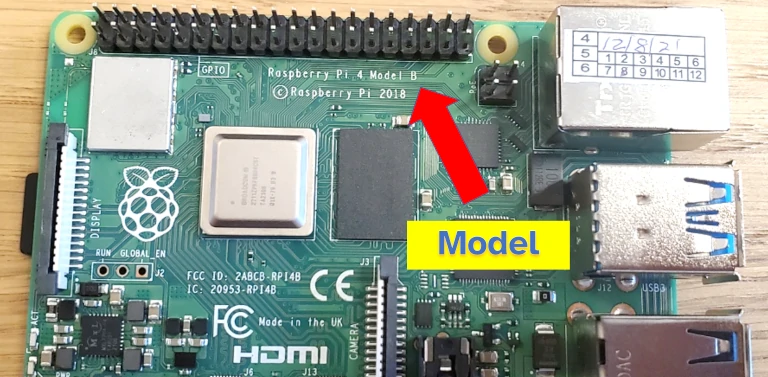How to Know Which Pi You Have
Figuring out which Raspberry Pi you lot're looking at can be confusing. At least that'southward how I felt when I was in the shop examining the lath I was given to see if it was the Raspberry Pi I was looking for. I put together this listing to help anyone in the same situation – or who may not have access to the board itself – to figure out which Raspberry Pi they are working with.
Each Raspberry Pi can be identified by its family (1-4, 400, Zilch, Pico) and its model name (A, B, A+, B+). Model names indicate whether the board has Ethernet (A ways no Ethernet), and if the board is an comeback on a previous one (calculation a + indicates an improved version of the same model). Each model can also take different amounts of retentivity.
This guide looks at how to figure out the Raspberry Pi family unit and model number using the last, by identifying the processor model, past counting the number of peripherals, or by measuring the size of the board itself.
1. Display model name from terminal
The concluding can display which model of Raspberry Pi is currently in employ, including the proper name of the family unit and the version.
To have the last display the model of Raspberry Pi:
- Open the terminal
- Enter the command:
cat /sys/firmware/devicetree/base/model - Read the Raspberry Pi model number

Quick hint from my lessons learnt: Press the tab key to autocomplete a word after typing a few letters. If there is more than than ane choice, try typing another letter of the alphabet and then tab once again, or keep pressing tab to cycle through the options.
What this command is doing is reading from a special file that the operating system keeps well-nigh the hardware that it's running on. The cat command reads this file and displays it in the concluding.
An alternative command which as well prints the Raspberry Pi version is (as well entered into terminal):
true cat /proc/cpuinfo 
This control lists out details nigh the CPU, which on Raspberry Pi boards includes the model of the Raspberry Pi.
I tested these commands on the Raspberry Pi Os, but they should work on other Linux versions that give y'all admission to the terminal (particularly the /proc/cpuinfo one).
If you lot're interested in more than things that tin can be done from the concluding, check out my guide on how to install a agglomeration of databases (similar SQLite and MariaDB) here: chipwired.com/databases-for-raspberry-pi
ii. Read the processor characterization on board
At the eye of every Raspberry Pi is the microprocessor responsible for running the all the programs and apps. Each family of Raspberry Pi uses a dissimilar processor.
The processor model, printed on pinnacle of the chip, tin be a quick mode to identify the family of Raspberry Pi. Each model of processor can be identified by reading the first set of messages and numbers subsequently the Broadcom mark (see photograph and tabular array below – your Raspberry Pi might besides have BCM as function of the prefix to the label).

A list of Raspberry Pi processor labels is in the tabular array below:
| Raspberry Pi Family unit | Processor Characterization |
|---|---|
| RPi 4 and 400 | 2711 |
| RPi iii | 2837 |
| RPi 2 | 2836 or 2837 |
| RPi (1) | 2835 |
| RPi Zero | 2835 |
| RPi Pico | Raspberry Pi logo |
Raspberry Pi 4 and Raspberry Pi 400 should be able to exist differentiated by the presence of the keyboard for the 400. On the inside, the Raspberry Pi 400 is pretty much a Raspberry Pi 4 with 4GB of memory (and ane less USB port).
3. Count the connectors on the board
Different Raspberry Pi models take a dissimilar number of connectors (USB, HDMI etc.).
A few easy ways to tell models apart past connector blazon:
- Ethernet is only present on Raspberry Pi "B" models, "A" models do not come with Ethernet
- HDMI is used for Raspberry Pi families 1-three, while HDMI micro is used for Raspberry Pi 4 and 400, and HDMI mini is used for the Raspberry Pi Goose egg. The Raspberry Pi Pico does not have HDMI.
- USB connectors are available on most Raspberry Pi boards, typically there are 1, two, or iv connectors (see table beneath)
The below table lists out the number of USB connectors for each model of Raspberry Pi:
| Model | USB Connectors |
|---|---|
| RPi 4 Model B | 4 (+1 USB-C for ability just) |
| RPi 400 | 3 (+1 USB-C for power only) |
| RPi three Model B+ | 4 |
| RPi 3 Model A+ | one |
| RPi three Model B | four |
| RPi 2 Model B | 4 |
| RPi 1 Model B+ | four |
| RPi 1 Model A+ | 1 |
| RPi 1 Model B | 2 |
| RPi 1 Model A | 1 |
| RPi Pico | 0 |
| RPi Zip | one (micro USB) |
A Raspberry Pi iv board will have 4 USB connector plus an additional USB-C connector. The USB-C connector is just for power though, it does non work with any USB-C device (I've tried keyboards, mouse, a USB-C hub, and fifty-fifty a screen – nothing will work in this USB-C connector).
I ensured this listing was complete using the official Raspberry Pi tech specs: RPi iv Model B; RPi 400; RPi 3 Model B+; RPi three Model A+; RPi 3 Model B; RPi i Model B+; RPi 1 Model A+; RPi Aught.
An additional connector available on Raspberry Pi models – the GPIO – can be used to connect sensors for collecting data (a common model for Raspberry Pi projects). I wrote a whole guide near how to collect information using Raspberry Pi, check it out here: chipwired.com/collect-data-with-raspberry-pi
iv. Read model name from board
Every Raspberry Pi I've seen has the family and model name printed on the lath itself. The name volition typically be printed on the front of the lath.

Annotation that the copyright yr doesn't reflect the board year; the board in the picture was manufactured afterwards 2019 (the shop I bought it from even marked the purchase date – run into the sticker on top of the Ethernet connector).
5. Check the dimensions of the board
Raspberry Pi are typically near 5.6cm (2.2inch) wide and 6.5-8.5cm (two.5-iii.4inch) long. This corresponds to roughly ii.2 inches wide and 2.five-3.four inches long. The smallest Raspberry Pi is the Pico which is about 5cm by 2cm.
The length and width of Raspberry Pi boards is listed in the table below:
| Model | Length | Width |
|---|---|---|
| RPi 4 Model B | 8.5cm / 3.4in | 5.6cm / 2.2in |
| RPi 400 | 28.6cm / 11.2in | 11.3cm / iv.4in |
| RPi iii Model B+ | 8.5cm / three.4in | 5.6cm / 2.2in |
| RPi iii Model A+ | 6.5cm / 2.5in | 5.6cm / 2.2in |
| RPi three Model B | 8.5cm / iii.4in | 5.6cm / two.2in |
| RPi ii Model B | 8.5cm / iii.4in | 5.6cm / 2.2in |
| RPi 1 Model B+ | viii.5cm / 3.4in | v.6cm / 2.2in |
| RPi i Model A+ | 6.5cm / 2.5in | 5.6cm / 2.2in |
| RPi 1 Model B | 8.5cm / three.4in | v.6cm / 2.2in |
| RPi one Model A | 8.5cm / 3.4in | 5.6cm / 2.2in |
| RPi Pico | 5.1cm / 2in | 2.1cm / 0.8in |
| RPi Nada | 6.5cm / ii.6in | 3.0cm / 1.2in |
I plant Raspberry Pi fairly consistent at keeping to the same board footprint throughout the various models.
vi. Look at the fleck configuration
Some Raspberry Pi models within the aforementioned family can have a unlike layout of chips on the front of the board.
For case, the divergence between the Raspberry Pi iv (4GB) and the Raspberry Pi 4 (8GB) is the presence of this VLI chip (encounter photo beneath). On the 8gb model, this chip was removed.
Chris is fascinated by the amount of power that tin can be found in such a compact package. Even though he has many years of feel working with embedded electronics and tiny computers, he still faced some challenges (such as identifying which board he was ownership!) when he first started out with Raspberry Pi
Source: https://chipwired.com/identify-raspberry-pi-board/
0 Response to "How to Know Which Pi You Have"
Post a Comment